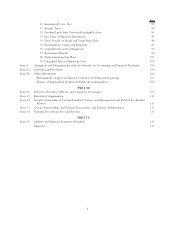Northrop Grumman 2010 Annual Report Download - page 17
Download and view the complete annual report
Please find page 17 of the 2010 Northrop Grumman annual report below. You can navigate through the pages in the report by either clicking on the pages listed below, or by using the keyword search tool below to find specific information within the annual report.
PATENTS
The following table summarizes the number of patents we own or have pending as of December 31, 2010:
Owned Pending Total
U.S. patents 3,192 329 3,521
Foreign patents 2,355 553 2,908
Total 5,547 882 6,429
Patents developed while under contract with the U.S. Government may be subject to use by the
U.S. Government. We license intellectual property to, and from, third parties. We believe our ability to conduct
operations would not be materially affected by the loss of any particular intellectual property right. See Risk
Factors in Part I, Item 1A.
SEASONALITY
No material portion of our business is considered to be seasonal. Our revenue recognition timing is based on
several factors, including the timing of contract awards, the incurrence of contract costs, cost estimation, and unit
deliveries. See Critical Accounting Policies, Estimates, and Judgments – Revenue Recognition in Part II, Item 7.
BACKLOG
At December 31, 2010, total backlog was $64.2 billion compared with $69.2 billion at the end of 2009.
Approximately 47 percent of backlog at December 31, 2010, is expected to be converted into sales in 2011.
Total backlog includes both funded backlog (firm orders for which funding is contractually obligated by the
customer) and unfunded backlog (firm orders for which funding is not currently contractually obligated by the
customer). Unfunded backlog excludes unexercised contract options and unfunded indefinite delivery indefinite
quantity (IDIQ) orders. For multi-year services contracts with non-federal government customers having no
stated contract values, backlog includes only the amounts committed by the customer. Backlog is converted into
sales as work is performed or deliveries are made. For backlog by segment see Backlog in Part II, Item 7.
RAW MATERIALS
The most significant raw material we require is steel, used primarily for shipbuilding. We have mitigated some
supply risk by negotiating long-term agreements with a number of steel suppliers. In addition, we have mitigated
price risk related to steel purchases through certain contractual arrangements with the U.S. Government. While
we have generally been able to obtain key raw materials required in our production processes in a timely
manner, a significant delay in supply deliveries could have a material adverse effect on our consolidated financial
position, results of operations, or cash flows. See Risk Factors in Part I, Item 1A and Overview – Outlook in
Part II, Item 7.
GOVERNMENT REGULATION
Our businesses are affected by numerous laws and regulations relating to the award, administration and
performance of U.S. Government contracts. See Risk Factors in Part I, Item 1A.
The U.S. Government generally has the ability to terminate our contracts, in whole or in part, without prior
notice, for convenience or for default based on performance. If any of our U.S. Government contracts were to
be terminated for convenience, we would generally be protected by provisions covering reimbursement for costs
incurred on the contracts and profit on those costs, but not the anticipated profit that would have been earned
had the contract been completed. In the rare circumstance where a U.S. Government contract does not have
such termination protection, we attempt to mitigate the termination risk through other means. Termination
resulting from our default may expose us to liability and could have a material adverse effect on our ability to
compete for contracts. See Risk Factors in Part I, Item 1A.
-7-
NORTHROP GRUMMAN CORPORATION
























